Mesenchymal Stem Cells in Nerve Tissue Engineering: Bridging Nerve Gap Injuries in Large Animals
Abstract
1. Introduction
2. Methods
2.1. Eligibility Criteria
2.2. Search Strategy and Study Selection
3. Results
3.1. Scaffold Materials Used for Nerve Guidance Grafts
3.2. Stem Cells Used for Nerve Repair
3.2.1. Neural Stem Cells for Treating Peripheral Nerve Injuries of Large Animals
| Author | Animal Species | Nerve Graft Composition | Cell Source | Experimental Model | Follow-Up (Days) |
|---|---|---|---|---|---|
| Choi et al., 2005 [29] | Rabbit | Autologous vein/collagen | BMSCs | 15 mm peroneal nerve defect | 90 |
| Hu et al., 2007 [7] | Rhesus macaque | Acellular allogenic nerve | BMSCs | 40 mm ulnar nerve defect | 180 |
| Braga et al., 2008 [43] | Human | Silicone tube | BMSCs | 20–50 mm nerves in forearm | 360 |
| Wang et al., 2008 [54] | Rhesus macaque | Acellular allogenic nerve | BMSCs | 10 mm radial nerve defect | 60 |
| Guo et al., 2008 [47] | Rabbit | Chitosan/collagen | NSCs | 10 mm facial nerve defect | 120 |
| Ding et al., 2010 [4] | Dog | Chitosan/PLGA | BMSCs | 50 mm sciatic nerve defect | 180 |
| Wakao et al., 2010 [48] | Crab-eating macaque | PLAC/collagen | BMSCs-SCLCs | 20 mm median nerve defect | 360 |
| Wang et al., 2010 [53] | Rhesus macaque | Acellular allogenic nerve | BMSCs | 25 mm radial nerve defect | 150 |
| Shen et al., 2010 [57] | Rabbit | - | BMSCs | 10 mm sciatic nerve defect | 15 |
| Cheng et al., 2011 [56] | Rabbit | (None) | NSCs | 10 mm sciatic nerve defect | 75 |
| Wang X. et al., 2011 [52] | Rabbit | Autologous vein | SCLCs- BMSCs | 10 mm facial nerve defect | 150 |
| Park et al., 2012 [58] | Pig | Collagen/fibrin | SK-MSCs | 10 mm femoral nerve defect | 30 |
| Xue et al., 2012 [45] | Dog | Chitosan/PLGA | BMSCs | 60 mm sciatic nerve defect | 360 |
| Duan et al., 2012 [40] | Rabbits | - | MSCs | 10 mm sciatic nerve defect | 70 |
| Hara et al., 2012 [59] | Cynomolgus monkeys | Nerve lengthening | - | 20 mm median nerve defect | 112 |
| Ghoreishian et al., 2013 [41] | Dog | ePTFE/alginate hydrogel | ASCs | 7 mm facial nerve defect | 120 |
| Hu et al., 2013 [46] | Rhesus macaque | Chitosan/PLGA | BMSCs | 50 mm median nerve defect | 360 |
| Casañas et al., 2014 [50] | Sheep | PLAC | BMSCs | 10 mm tibial and radial nerve defect | 180 |
| Wang et al., 2014 [60] | Rhesus macaque | Acellular allografts | BMSCs | 25 mm radial nerve defect | 150 |
| Lasso et al., 2015 [51] | Rabbit | Autologous vein/fibrin | ASCs | 4 0 mm peroneal nerve defect | 90 |
| Trindade et al., 2015 [42] | Rabbit | Silicone tube | BMSCs | 5 mm femoral nerve defect | 75 |
| Xiao et al., 2015 [44] | Rabbit | Chitosan | UC-MSCs | Peroneal end-to-side anastomosis | 120 |
| Kaizawa et al., 2016 [49] | Dog | PLAC, artery | BMSCs | 30 mm ulnar nerve defect | 180 |
| Jiang et al., 2016 [61] | Rhesus macaque | Acellular nerve allografts | Allogeneic Schwann cells | 40 mm ulnar nerve defect | 150 |
| Su et al., 2018 [62] | Mini-pigs | PLA conduit | hAF-MSCs | 15 mm sciatic nerve defect | 600 |
| Cui et al., 2018 [63] | Dogs | Longitudinally- oriented collagen conduit | hUC-MSCs | 35 mm sciatic nerve defect | 270 |
| Sun et al., 2018 [64] | Rabbits | Xenografts and autografts | ASCs and PRP | 10 mm facial nerve defect | 56 |
| Mitsuzawa et al., 2019 [65] | Beagle dogs | Scaffold-free 3D conduits | Dermal FBCs | 5 mm ulnar nerve defect | 70 |
| Fadia et al., 2020 [66] | Rhesus macaque | Poly (caprolactone) conduit and median nerve autograft | Micro-particles releasing GDNF | 50 mm median nerve defect | 365 |
| Daradka et al., 2021 [67] | Mongrel dogs | Autologous saphenous vein graft | Autologous PRP BMSCs | 10 mm facial nerve defect | 56 |
| Kornfeld et al., 2021 [39] | Sheep | Silk fibroin NGCs | ECM | 60 mm tibial nerve defect | 180 |
| Contreras et al., 2022 [37] | Sheep | Acellular nerve allograft | ECM | 50 mm/70 mm peroneal nerve defect | 270 |
| Contreras et al., 2023 [36] | Sheep | Acellular nerve allograft | ECM | 70 mm peroneal nerve defect | 270 |
| Holzer et al., 2023 [38] | Rhesus macaque | Acellular nerve xenograft | ECM | 40 mm radial nerve defect | 360 |
3.2.2. Bone Marrow-Derived Stem Cells Promote Nerve Regeneration in Large Animals
3.2.3. Other Cells and Factors Used for Nerve Tissue Engineering Applications
4. Conclusions and Future Perspectives
Author Contributions
Funding
Data Availability Statement
Acknowledgments
Conflicts of Interest
References
- Böcker, A.; Aman, M.; Kneser, U.; Harhaus, L.; Siemers, F.; Stang, F. Closing the Gap: Bridging Peripheral Sensory Nerve Defects with a Chitosan-Based Conduit a Randomized Prospective Clinical Trial. J. Pers. Med. 2022, 12, 900. [Google Scholar] [CrossRef] [PubMed]
- Hopf, A.; Al-Bayati, L.; Schaefer, D.J.; Kalbermatten, D.F.; Guzman, R.; Madduri, S. Optimized Decellularization Protocol for Large Peripheral Nerve Segments: Towards Personalized Nerve Bioengineering. Bioengineering 2022, 9, 412. [Google Scholar] [CrossRef]
- Bain, J.R.; Mackinnon, S.E.; Hudson, A.R.; Wade, J.; Evans, P.; Makino, A.; Hunter, D. The peripheral nerve allograft in the primate immunosuppressed with Cyclosporin A: I. Histologic and electrophysiologic assessment. Plast. Reconstr. Surg. 1992, 90, 1036–1046. [Google Scholar] [CrossRef] [PubMed]
- Ding, F.; Wu, J.; Yang, Y.; Hu, W.; Zhu, Q.; Tang, X.; Liu, J.; Gu, X. Use of tissue-engineered nerve grafts consisting of a chitosan/poly(lactic-co-glycolic acid)-based scaffold included with bone marrow mesenchymal cells for bridging 50-mm dog sciatic nerve gaps. Tissue Eng. Part A 2010, 16, 3779–3790. [Google Scholar] [CrossRef] [PubMed]
- Prautsch, K.M.; Degrugillier, L.; Schaefer, D.J.; Guzman, R.; Kalbermatten, D.F.; Madduri, S. Ex-Vivo Stimulation of Adipose Stem Cells by Growth Factors and Fibrin-Hydrogel Assisted Delivery Strategies for Treating Nerve Gap-Injuries. Bioengineering 2020, 7, 42. [Google Scholar] [CrossRef]
- Prautsch, K.M.; Schmidt, A.; Paradiso, V.; Schaefer, D.J.; Guzman, R.; Kalbermatten, D.F.; Madduri, S. Modulation of Human Adipose Stem Cells’ Neurotrophic Capacity Using a Variety of Growth Factors for Neural Tissue Engineering Applications: Axonal Growth, Transcriptional, and Phosphoproteomic Analyses In Vitro. Cells 2020, 9, 1939. [Google Scholar] [CrossRef]
- Hu, J.; Zhu, Q.T.; Liu, X.L.; Xu, Y.B.; Zhu, J.K. Repair of extended peripheral nerve lesions in rhesus monkeys using acellular allogenic nerve grafts implanted with autologous mesenchymal stem cells. Exp. Neurol. 2007, 204, 658–666. [Google Scholar] [CrossRef]
- Dezawa, M.; Takahashi, I.; Esaki, M.; Takano, M.; Sawada, H. Sciatic nerve regeneration in rats induced by transplantation of in vitro differentiated bone-marrow stromal cells. Eur. J. Neurosci. 2001, 14, 1771–1776. [Google Scholar] [CrossRef]
- Tohill, M.; Mantovani, C.; Wiberg, M.; Terenghi, G. Rat bone marrow mesenchymal stem cells express glial markers and stimulate nerve regeneration. Neurosci. Lett. 2004, 362, 200–203. [Google Scholar] [CrossRef]
- Keilhoff, G.; Goihl, A.; Langnase, K.; Fansa, H.; Wolf, G. Transdifferentiation of mesenchymal stem cells into Schwann cell-like myelinating cells. Eur. J. Cell Biol. 2006, 85, 11–24. [Google Scholar] [CrossRef]
- Caddick, J.; Kingham, P.J.; Gardiner, N.J.; Wiberg, M.; Terenghi, G. Phenotypic and functional characteristics of mesenchymal stem cells differentiated along a Schwann cell lineage. Glia 2006, 54, 840–849. [Google Scholar] [CrossRef] [PubMed]
- De Ugarte, D.A.; Morizono, K.; Elbarbary, A.; Alfonso, Z.; Zuk, P.A.; Zhu, M.; Dragoo, J.L.; Ashjian, P.; Thomas, B.; Benhaim, P.; et al. Comparison of multi-lineage cells from human adipose tissue and bone marrow. Cells Tissues Organs 2003, 174, 101–109. [Google Scholar] [CrossRef] [PubMed]
- Strem, B.M.; Hicok, K.C.; Zhu, M.; Wulur, I.; Alfonso, Z.; Schreiber, R.E.; Fraser, J.K.; Hedrick, M.H. Multipotential differentiation of adipose tissue-derived stem cells. Keio J. Med. 2005, 54, 132–141. [Google Scholar] [CrossRef] [PubMed]
- Cruciani, S.; Santaniello, S.; Montella, A.; Ventura, C.; Maioli, M. Orchestrating stem cell fate: Novel tools for regenerative medicine. World J. Stem. Cells 2019, 11, 464–475. [Google Scholar] [CrossRef]
- Mazzini, L.; Ferrari, D.; Andjus, P.R.; Buzanska, L.; Cantello, R.; De Marchi, F.; Gelati, M.; Giniatullin, R.; Glover, J.C.; Grilli, M.; et al. Advances in stem cell therapy for amyotrophic lateral sclerosis. Expert Opin. Biol. Ther. 2018, 18, 865–881. [Google Scholar] [CrossRef]
- Nakagami, H.; Maeda, K.; Morishita, R.; Iguchi, S.; Nishikawa, T.; Takami, Y.; Kikuchi, Y.; Saito, Y.; Tamai, K.; Ogihara, T.; et al. Novel autologous cell therapy in ischemic limb disease through growth factor secretion by cultured adipose tissue-derived stromal cells. Arterioscler. Thromb. Vasc. Biol. 2005, 25, 2542–2547. [Google Scholar] [CrossRef]
- Zuk, P.A.; Zhu, M.; Ashjian, P.; De Ugarte, D.A.; Huang, J.I.; Mizuno, H.; Alfonso, Z.C.; Fraser, J.K.; Benhaim, P.; Hedrick, M.H. Human adipose tissue is a source of multipotent stem cells. Mol. Biol. Cell 2002, 13, 279–295. [Google Scholar] [CrossRef]
- El Atat, O.; Antonios, D.; Hilal, G.; Hokayem, N.; Abou-Ghoch, J.; Hashim, H.; Serhal, R.; Hebbo, C.; Moussa, M.; Alaaeddine, N. An Evaluation of the Stemness, Paracrine, and Tumorigenic Characteristics of Highly Expanded, Minimally Passaged Adipose-Derived Stem Cells. PLoS ONE 2016, 11, e0162332. [Google Scholar] [CrossRef]
- Fang, Y.; Zhang, Y.; Zhou, J.; Cao, K. Adipose-derived mesenchymal stem cell exosomes: A novel pathway for tissues repair. Cell Tissue Bank 2019, 20, 153–161. [Google Scholar] [CrossRef]
- Santiago, L.Y.; Clavijo-Alvarez, J.; Brayfield, C.; Rubin, J.P.; Marra, K.G. Delivery of adipose-derived precursor cells for peripheral nerve repair. Cell Transplant. 2009, 18, 145–158. [Google Scholar] [CrossRef]
- Salgado, A.J.; Reis, R.L.; Sousa, N.J.; Gimble, J.M. Adipose tissue derived stem cells secretome: Soluble factors and their roles in regenerative medicine. Curr. Stem Cell Res. Ther. 2010, 5, 103–110. [Google Scholar] [CrossRef] [PubMed]
- Marconi, S.; Castiglione, G.; Turano, E.; Bissolotti, G.; Angiari, S.; Farinazzo, A.; Constantin, G.; Bedogni, G.; Bedogni, A.; Bonetti, B. Human adipose-derived mesenchymal stem cells systemically injected promote peripheral nerve regeneration in the mouse model of sciatic crush. Tissue Eng Part A 2012, 18, 1264–1272. [Google Scholar] [CrossRef] [PubMed]
- Bellei, B.; Migliano, E.; Tedesco, M.; Caputo, S.; Papaccio, F.; Lopez, G.; Picardo, M. Adipose tissue-derived extracellular fraction characterization: Biological and clinical considerations in regenerative medicine. Stem Cell. Res. Ther. 2018, 9, 207. [Google Scholar] [CrossRef] [PubMed]
- Vasilev, G.; Ivanova, M.; Ivanova-Todorova, E.; Tumangelova-Yuzeir, K.; Krasimirova, E.; Stoilov, R.; Kyurkchiev, D. Secretory factors produced by adipose mesenchymal stem cells downregulate Th17 and increase Treg cells in peripheral blood mononuclear cells from rheumatoid arthritis patients. Rheumatol. Int. 2019, 39, 819–826. [Google Scholar] [CrossRef] [PubMed]
- Erba, P.; Mantovani, C.; Kalbermatten, D.F.; Pierer, G.; Terenghi, G.; Kingham, P.J. Regeneration potential and survival of transplanted undifferentiated adipose tissue-derived stem cells in peripheral nerve conduits. J. Plast. Reconstr. Aesthet. Surg. 2010, 63, e811–e817. [Google Scholar] [CrossRef] [PubMed]
- Aust, L.; Devlin, B.; Foster, S.J.; Halvorsen, Y.D.; Hicok, K.; du Laney, T.; Sen, A.; Willingmyre, G.D.; Gimble, J.M. Yield of human adipose-derived adult stem cells from liposuction aspirates. Cytotherapy 2004, 6, 7–14. [Google Scholar] [CrossRef]
- McIntosh, K.R.; Lopez, M.J.; Borneman, J.N.; Spencer, N.D.; Anderson, P.A.; Gimble, J.M. Immunogenicity of allogeneic adipose-derived stem cells in a rat spinal fusion model. Tissue Eng. Part A 2009, 15, 2677–2686. [Google Scholar] [CrossRef]
- Dezawa, M.; Kanno, H.; Hoshino, M.; Cho, H.; Matsumoto, N.; Itokazu, Y.; Tajima, N.; Yamada, H.; Sawada, H.; Ishikawa, H.; et al. Specific induction of neuronal cells from bone marrow stromal cells and application for autologous transplantation. J. Clin. Invest. 2004, 113, 1701–1710. [Google Scholar] [CrossRef]
- Choi, B.H.; Zhu, S.J.; Kim, B.Y.; Huh, J.Y.; Lee, S.H.; Jung, J.H. Transplantation of cultured bone marrow stromal cells to improve peripheral nerve regeneration. Int. J. Oral Maxillofac. Surg. 2005, 34, 537–542. [Google Scholar] [CrossRef]
- Murakami, T.; Fujimoto, Y.; Yasunaga, Y.; Ishida, O.; Tanaka, N.; Ikuta, Y.; Ochi, M. Transplanted neuronal progenitor cells in a peripheral nerve gap promote nerve repair. Brain Res. 2003, 974, 17–24. [Google Scholar] [CrossRef]
- Gulati, A.K.; Rai, D.R.; Ali, A.M. The influence of cultured Schwann cells on regeneration through acellular basal lamina grafts. Brain Res. 1995, 705, 118–124. [Google Scholar] [CrossRef] [PubMed]
- Hopf, A.; Schaefer, D.J.; Kalbermatten, D.F.; Guzman, R.; Madduri, S. Schwann Cell-Like Cells: Origin and Usability for Repair and Regeneration of the Peripheral and Central Nervous System. Cells 2020, 9, 1990. [Google Scholar] [CrossRef]
- Geuna, S. The sciatic nerve injury model in pre-clinical research. J. Neurosci. Methods 2015, 243, 39–46. [Google Scholar] [CrossRef]
- Mohanty, C.B.; Bhat, D.I.; Devi, B.I. Use of animal models in peripheral nerve surgery and research. Neurol. India 2019, 67, S100–S105. [Google Scholar] [PubMed]
- Vela, F.J.; Martínez-Chacón, G.; Ballestín, A.; Campos, J.L.; Sánchez-Margallo, F.M.; Abellán, E. Animal models used to study direct peripheral nerve repair: A systematic review. Neural Regen. Res. 2020, 15, 491–502. [Google Scholar] [CrossRef]
- Contreras, E.; Traserra, S.; Bolívar, S.; Forés, J.; Jose-Cunilleras, E.; Delgado-Martínez, I.; García, F.; Udina, E.; Navarro, X. Repair of Long Peripheral Nerve Defects in Sheep: A Translational Model for Nerve Regeneration. Int. J. Mol. Sci. 2023, 24, 1333. [Google Scholar] [CrossRef] [PubMed]
- Contreras, E.; Traserra, S.; Bolívar, S.; Forés, J.; Jose-Cunilleras, E.; García, F.; Delgado-Martínez, I.; Holmgren, S.; Strehl, R.; Udina, E.; et al. Repair of Long Nerve Defects with a New Decellularized Nerve Graft in Rats and in Sheep. Cells 2022, 11, 4074. [Google Scholar] [CrossRef] [PubMed]
- Holzer, P.; Chang, E.J.; Rogers, K.; Tarlton, J.; Lu, D.; Gillespie, N.; Adkins, J.; Metea, M.; LaRochelle, A.; Wicks, J.; et al. Large-gap peripheral nerve repair using xenogeneic transplants in rhesus macaques. Xenotransplantation 2023, 30, e12792. [Google Scholar] [CrossRef]
- Kornfeld, T.; Nessler, J.; Helmer, C.; Hannemann, R.; Waldmann, K.H.; Peck, C.T.; Hoffmann, P.; Brandes, G.; Vogt, P.M.; Radtke, C. Spider silk nerve graft promotes axonal regeneration on long distance nerve defect in a sheep model. Biomaterials 2021, 271, 120692. [Google Scholar] [CrossRef]
- Duan, X.H.; Cheng, L.N.; Zhang, F.; Liu, J.; Guo, R.M.; Zhong, X.M.; Wen, X.H.; Shen, J. In vivo MRI monitoring nerve regeneration of acute peripheral nerve traction injury following mesenchymal stem cell transplantation. Eur. J. Radiol. 2012, 81, 2154–2160. [Google Scholar] [CrossRef]
- Ghoreishian, M.; Rezaei, M.; Beni, B.H.; Javanmard, S.H.; Attar, B.M.; Zalzali, H. Facial nerve repair with Gore-Tex tube and adipose-derived stem cells: An animal study in dogs. J. Oral Maxillofac. Surg. 2013, 71, 577–587. [Google Scholar] [CrossRef]
- Trindade, A.B.; Schestatsky, P.; Torres, V.F.; Gomes, C.; Gianotti, G.C.; Paz, A.H.; Terraciano, P.B.; Marques, J.M.; Guimarães, K.M.; Graça, D.L.; et al. Functional and regenerative effects of local administration of autologous mononuclear bone marrow cells combined with silicone conduit on transected femoral nerve of rabbits. Res. Vet. Sci. 2015, 102, 27–33. [Google Scholar] [CrossRef]
- Braga-Silva, J.; Gehlen, D.; Padoin, A.V.; Machado, D.C.; Garicochea, B.; Costa da Costa, J. Can local supply of bone marrow mononuclear cells improve the outcome from late tubular repair of human median and ulnar nerves? J. Hand Surg. Eur. Vol. 2008, 33, 488–493. [Google Scholar] [CrossRef]
- Xiao, Q.; Zhang, X.; Wu, Y. Experimental Research on Differentiation-Inducing Growth of Nerve Lateral Bud by HUC-MSCs Chitosan Composite Conduit. Cell Biochem. Biophys. 2015, 73, 305–311. [Google Scholar] [CrossRef] [PubMed]
- Xue, C.; Hu, N.; Gu, Y.; Yang, Y.; Liu, Y.; Liu, J.; Ding, F.; Gu, X. Joint use of a chitosan/PLGA scaffold and MSCs to bridge an extra large gap in dog sciatic nerve. Neurorehabil. Neural Repair 2012, 26, 96–106. [Google Scholar] [CrossRef] [PubMed]
- Hu, N.; Wu, H.; Xue, C.; Gong, Y.; Wu, J.; Xiao, Z.; Yang, Y.; Ding, F.; Gu, X. Long-term outcome of the repair of 50 mm long median nerve defects in rhesus monkeys with marrow mesenchymal stem cells-containing, chitosan-based tissue engineered nerve grafts. Biomaterials 2013, 34, 100–111. [Google Scholar] [CrossRef] [PubMed]
- Guo, B.F.; Dong, M.M. Application of neural stem cells in tissue-engineered artificial nerve. Otolaryngol. Head Neck Surg. 2009, 140, 159–164. [Google Scholar] [CrossRef]
- Wakao, S.; Hayashi, T.; Kitada, M.; Kohama, M.; Matsue, D.; Teramoto, N.; Ose, T.; Itokazu, Y.; Koshino, K.; Watabe, H.; et al. Long-term observation of auto-cell transplantation in non-human primate reveals safety and efficiency of bone marrow stromal cell-derived Schwann cells in peripheral nerve regeneration. Exp. Neurol. 2010, 223, 537–547. [Google Scholar] [CrossRef]
- Kaizawa, Y.; Kakinoki, R.; Ikeguchi, R.; Ohta, S.; Noguchi, T.; Oda, H.; Matsuda, S. Bridging a 30 mm defect in the canine ulnar nerve using vessel-containing conduits with implantation of bone marrow stromal cells. Microsurgery 2016, 36, 316–324. [Google Scholar] [CrossRef] [PubMed]
- Casanas, J.; de la Torre, J.; Soler, F.; Garcia, F.; Rodellar, C.; Pumarola, M.; Climent, J.; Soler, R.; Orozco, L. Peripheral nerve regeneration after experimental section in ovine radial and tibial nerves using synthetic nerve grafts, including expanded bone marrow mesenchymal cells: Morphological and neurophysiological results. Injury 2014, 45 (Suppl. S4), S2–S6. [Google Scholar] [CrossRef]
- Lasso, J.M.; Pérez Cano, R.; Castro, Y.; Arenas, L.; García, J.; Fernández-Santos, M.E. Xenotransplantation of human adipose-derived stem cells in the regeneration of a rabbit peripheral nerve. J. Plast. Reconstr. Aesthet. Surg. 2015, 68, e189–e197. [Google Scholar] [CrossRef] [PubMed]
- Wang, X.; Luo, E.; Li, Y.; Hu, J. Schwann-like mesenchymal stem cells within vein graft facilitate facial nerve regeneration and remyelination. Brain Res. 2011, 1383, 71–80. [Google Scholar] [CrossRef]
- Wang, D.; Liu, X.L.; Zhu, J.K.; Hu, J.; Jiang, L.; Zhang, Y.; Yang, L.M.; Wang, H.G.; Zhu, Q.T.; Yi, J.H.; et al. Repairing large radial nerve defects by acellular nerve allografts seeded with autologous bone marrow stromal cells in a monkey model. J. Neurotrauma 2010, 27, 1935–1943. [Google Scholar] [CrossRef] [PubMed]
- Wang, D.; Liu, X.L.; Zhu, J.K.; Jiang, L.; Hu, J.; Zhang, Y.; Yang, L.M.; Wang, H.G.; Yi, J.H. Bridging small-gap peripheral nerve defects using acellular nerve allograft implanted with autologous bone marrow stromal cells in primates. Brain Res. 2008, 1188, 44–53. [Google Scholar] [CrossRef]
- Madduri, S.; Gander, B. Growth factor delivery systems and repair strategies for damaged peripheral nerves. J. Control. Release 2012, 161, 274–282. [Google Scholar] [CrossRef]
- Cheng, L.N.; Duan, X.H.; Zhong, X.M.; Guo, R.M.; Zhang, F.; Zhou, C.P.; Shen, J. Transplanted neural stem cells promote nerve regeneration in acute peripheral nerve traction injury: Assessment using MRI. AJR Am. J. Roentgenol. 2011, 196, 1381–1387. [Google Scholar] [CrossRef]
- Shen, J.; Duan, X.H.; Cheng, L.N.; Zhong, X.M.; Guo, R.M.; Zhang, F.; Zhou, C.P.; Liang, B.L. In vivo MR imaging tracking of transplanted mesenchymal stem cells in a rabbit model of acute peripheral nerve traction injury. J. Magn. Reson. Imaging 2010, 32, 1076–1085. [Google Scholar] [CrossRef] [PubMed]
- Park, B.W.; Kang, D.H.; Kang, E.J.; Byun, J.H.; Lee, J.S.; Maeng, G.H.; Rho, G.J. Peripheral nerve regeneration using autologous porcine skin-derived mesenchymal stem cells. J. Tissue Eng. Regen. Med. 2012, 6, 113–124. [Google Scholar] [CrossRef]
- Hara, Y.; Nishiura, Y.; Ochiai, N.; Sharula; Nakajima, Y.; Kubota, S.; Saijilafu; Mishima, H. New treatment for peripheral nerve defects: Reconstruction of a 2 cm, monkey median nerve gap by direct lengthening of both nerve stumps. J. Orthop. Res. 2012, 30, 153–161. [Google Scholar] [CrossRef]
- Wang, D.; Huang, X.; Fu, G.; Gu, L.; Liu, X.; Wang, H.; Hu, J.; Yi, J.; Niu, X.; Zhu, Q. A simple model of radial nerve injury in the rhesus monkey to evaluate peripheral nerve repair. Neural Regen. Res. 2014, 9, 1041–1046. [Google Scholar]
- Jiang, C.Q.; Hu, J.; Xiang, J.P.; Zhu, J.K.; Liu, X.L.; Luo, P. Tissue-engineered rhesus monkey nerve grafts for the repair of long ulnar nerve defects: Similar outcomes to autologous nerve grafts. Neural Regen. Res. 2016, 11, 1845–1850. [Google Scholar] [PubMed]
- Su, C.F.; Chang, L.H.; Kao, C.Y.; Lee, D.C.; Cho, K.H.; Kuo, L.W.; Chang, H.; Wang, Y.H.; Chiu, I.M. Application of amniotic fluid stem cells in repairing sciatic nerve injury in minipigs. Brain Res. 2018, 1678, 397–406. [Google Scholar] [CrossRef] [PubMed]
- Cui, Y.; Yao, Y.; Zhao, Y.; Xiao, Z.; Cao, Z.; Han, S.; Li, X.; Huan, Y.; Pan, J.; Dai, J. Functional collagen conduits combined with human mesenchymal stem cells promote regeneration after sciatic nerve transection in dogs. J. Tissue Eng. Regen. Med. 2018, 12, 1285–1296. [Google Scholar] [CrossRef] [PubMed]
- Sun, Y.; Zhang, R.; Mao, X.; Zhang, M. Research of acellular xenogeneic nerve combined with adipose-derived stem cells and platelet rich plasma in repair of rabbit facial nerve injury. Zhongguo Xiu Fu Chong Jian Wai Ke Za Zhi 2018, 32, 736–744. [Google Scholar]
- Mitsuzawa, S.; Ikeguchi, R.; Aoyama, T.; Takeuchi, H.; Yurie, H.; Oda, H.; Ohta, S.; Ushimaru, M.; Ito, T.; Tanaka, M.; et al. The Efficacy of a Scaffold-free Bio 3D Conduit Developed from Autologous Dermal Fibroblasts on Peripheral Nerve Regeneration in a Canine Ulnar Nerve Injury Model: A Preclinical Proof-of-Concept Study. Cell Transplant. 2019, 28, 1231–1241. [Google Scholar] [CrossRef]
- Fadia, N.B.; Bliley, J.M.; DiBernardo, G.A.; Crammond, D.J.; Schilling, B.K.; Sivak, W.N.; Spiess, A.M.; Washington, K.M.; Waldner, M.; Liao, H.T.; et al. Long-gap peripheral nerve repair through sustained release of a neurotrophic factor in nonhuman primates. Sci. Transl. Med. 2020, 12, eaav7753. [Google Scholar] [CrossRef]
- Daradka, M.H.; Bani Ismail, Z.A.; Irsheid, M.A. Peripheral nerve regeneration: A comparative study of the effects of autologous bone marrow-derived mesenchymal stem cells, platelet-rich plasma, and lateral saphenous vein graft as a conduit in a dog model. Open Vet. J. 2021, 11, 686–694. [Google Scholar] [CrossRef] [PubMed]
- Arabpour, M.; Saghazadeh, A.; Rezaei, N. Anti-inflammatory and M2 macrophage polarization-promoting effect of mesenchymal stem cell-derived exosomes. Int. Immunopharmacol. 2020, 97, 107823. [Google Scholar] [CrossRef]
- Lavorato, A.A.-O.; Raimondo, S.A.-O.X.; Boido, M.A.-O.; Muratori, L.A.-O.; Durante, G.; Cofano, F.; Vincitorio, F.; Petrone, S.A.-O.; Titolo, P.; Tartara, F.; et al. Mesenchymal Stem Cell Treatment Perspectives in Peripheral Nerve Regeneration: Systematic Review. Int. J. Mol. Sci. 2021, 22, 572. [Google Scholar] [CrossRef]
- Liu, Y.; Schwam, J.; Chen, Q. Senescence-Associated Cell Transition and Interaction (SACTAI): A Proposed Mechanism for Tissue Aging, Repair, and Degeneration. Cells 2022, 11, 1089. [Google Scholar] [CrossRef]
- Lyamina, S.; Baranovskii, D.; Kozhevnikova, E.; Ivanova, T.; Kalish, S.; Sadekov, T.; Klabukov, I.; Maev, I.; Govorun, V. Mesenchymal Stromal Cells as a Driver of Inflammaging. Int. J. Mol. Sci. 2023, 24, 6372. [Google Scholar] [CrossRef] [PubMed]
- Baranovskii, D.S.; Klabukov, I.D.; Arguchinskaya, N.V.; Yakimova, A.O.; Kisel, A.A.; Yatsenko, E.M.; Ivanov, S.A.; Shegay, P.V.; Kaprin, A.D. Adverse events, side effects and complications in mesenchymal stromal cell-based therapies. Stem Cell Investig. 2022, 9, 7. [Google Scholar] [CrossRef] [PubMed]

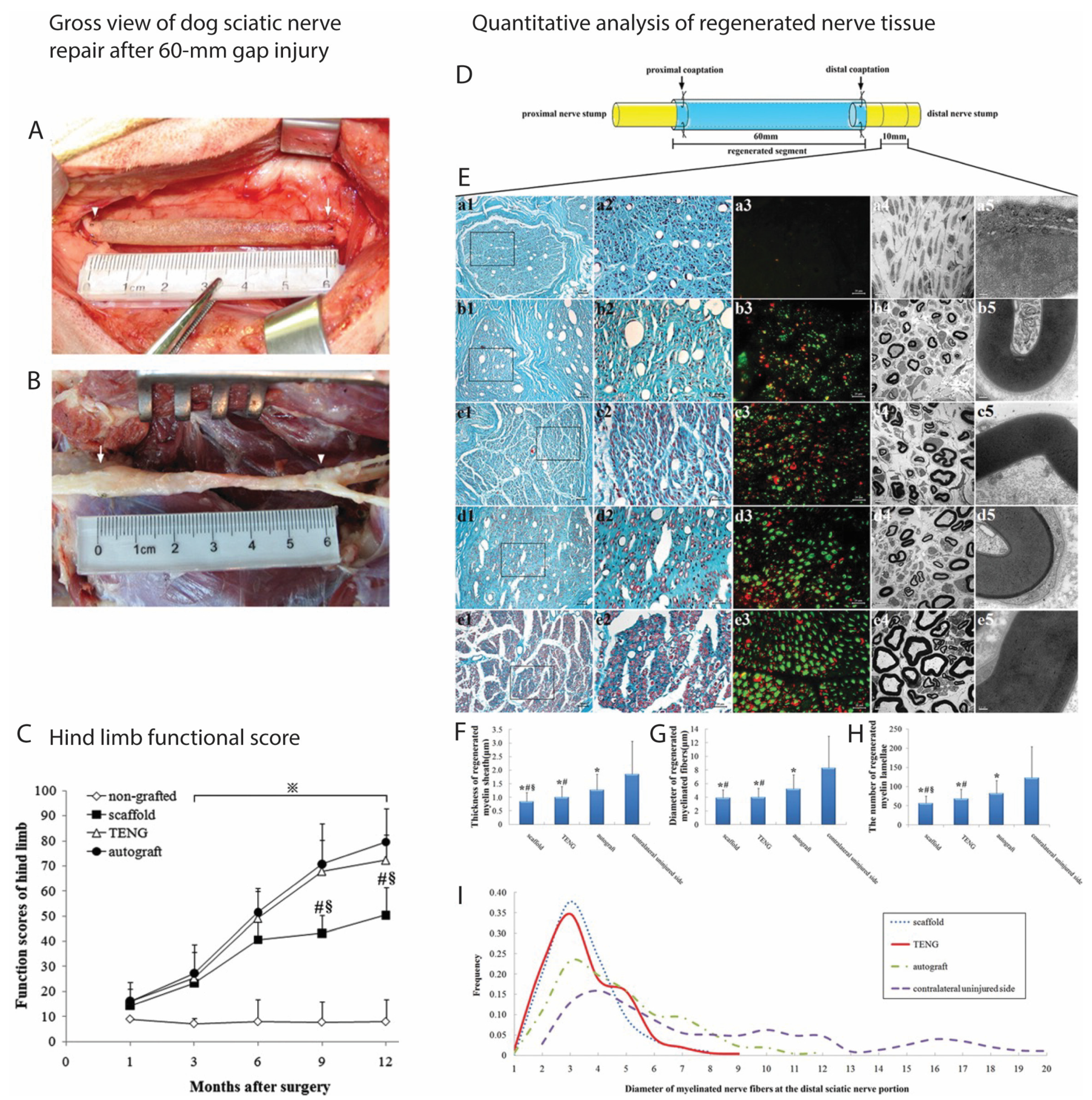
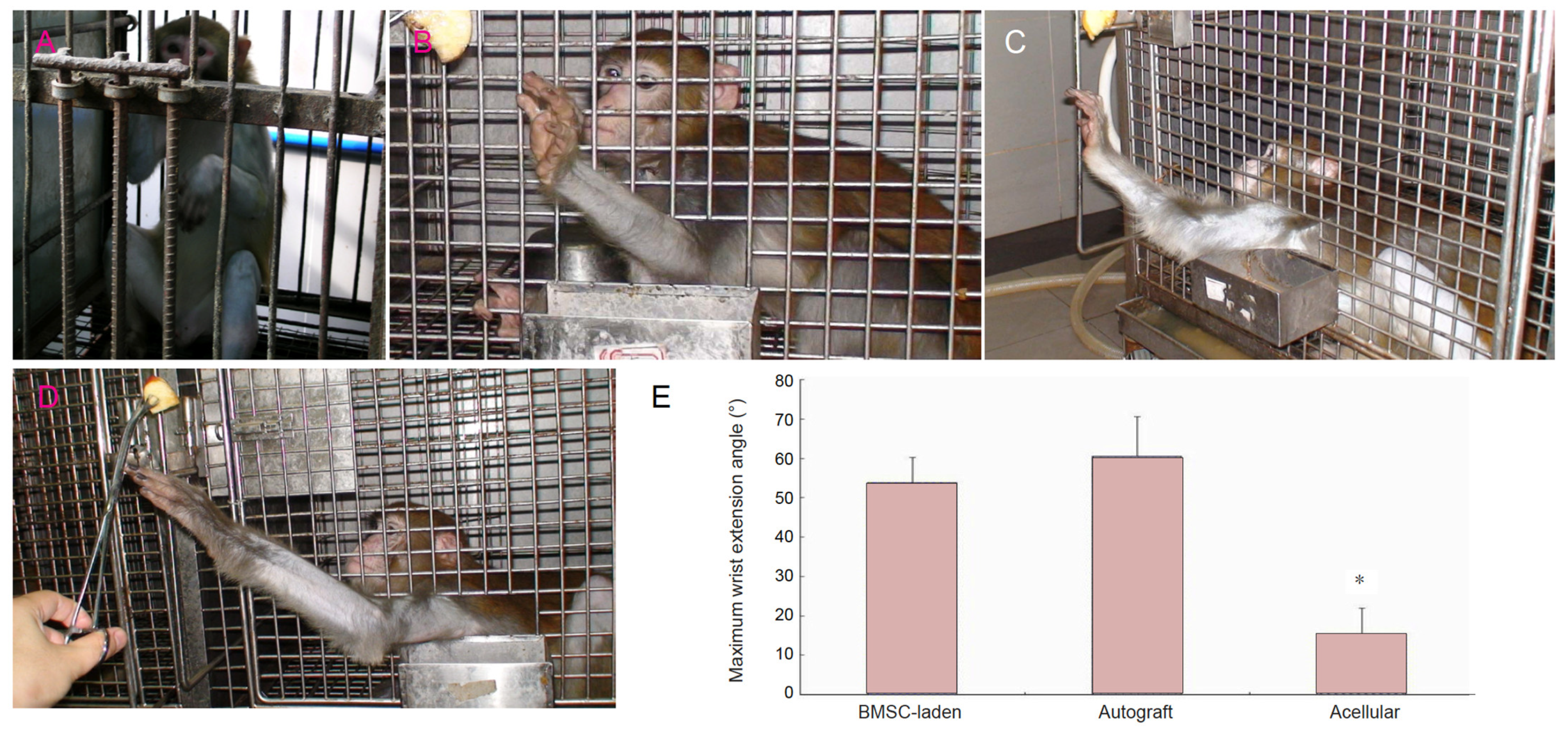
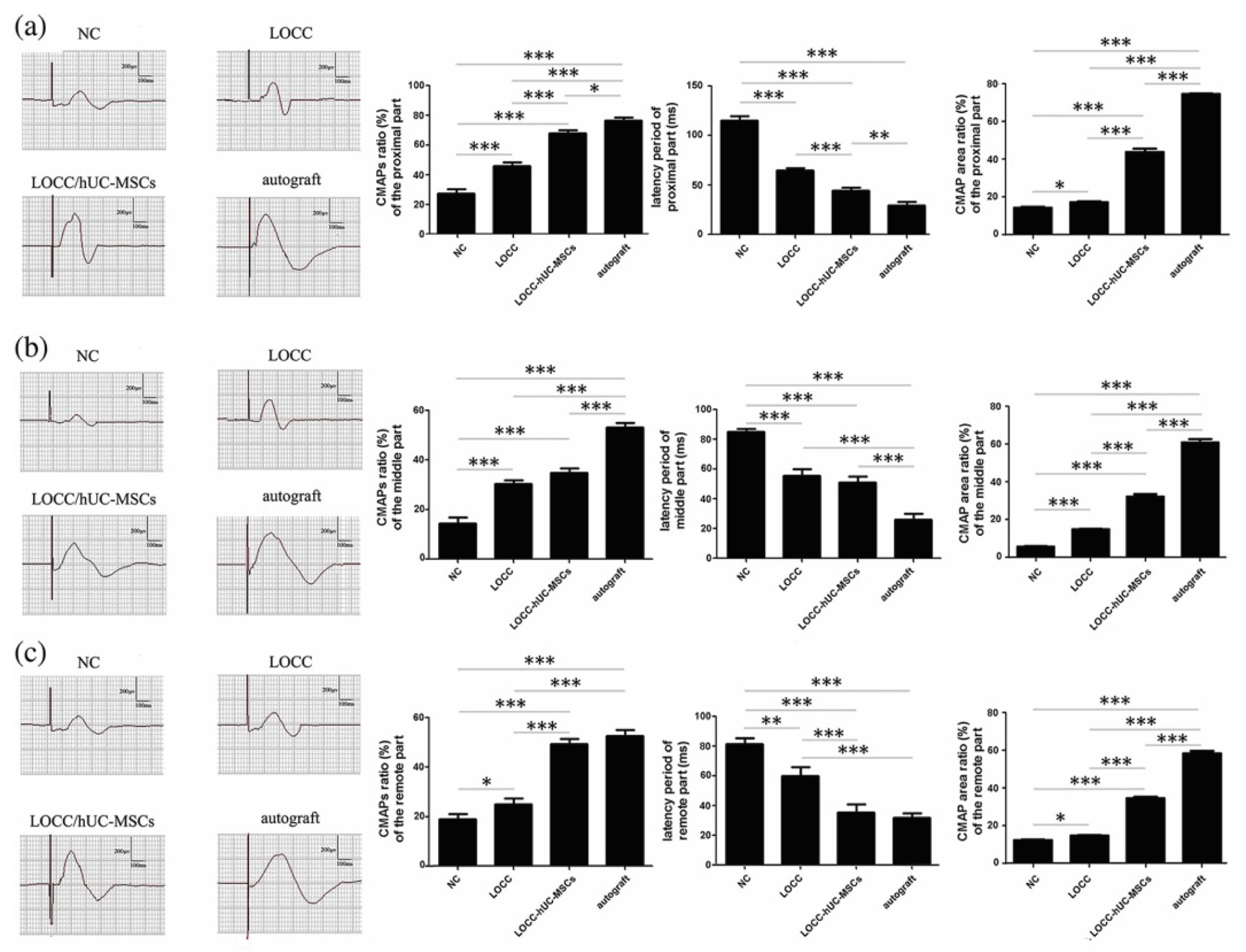
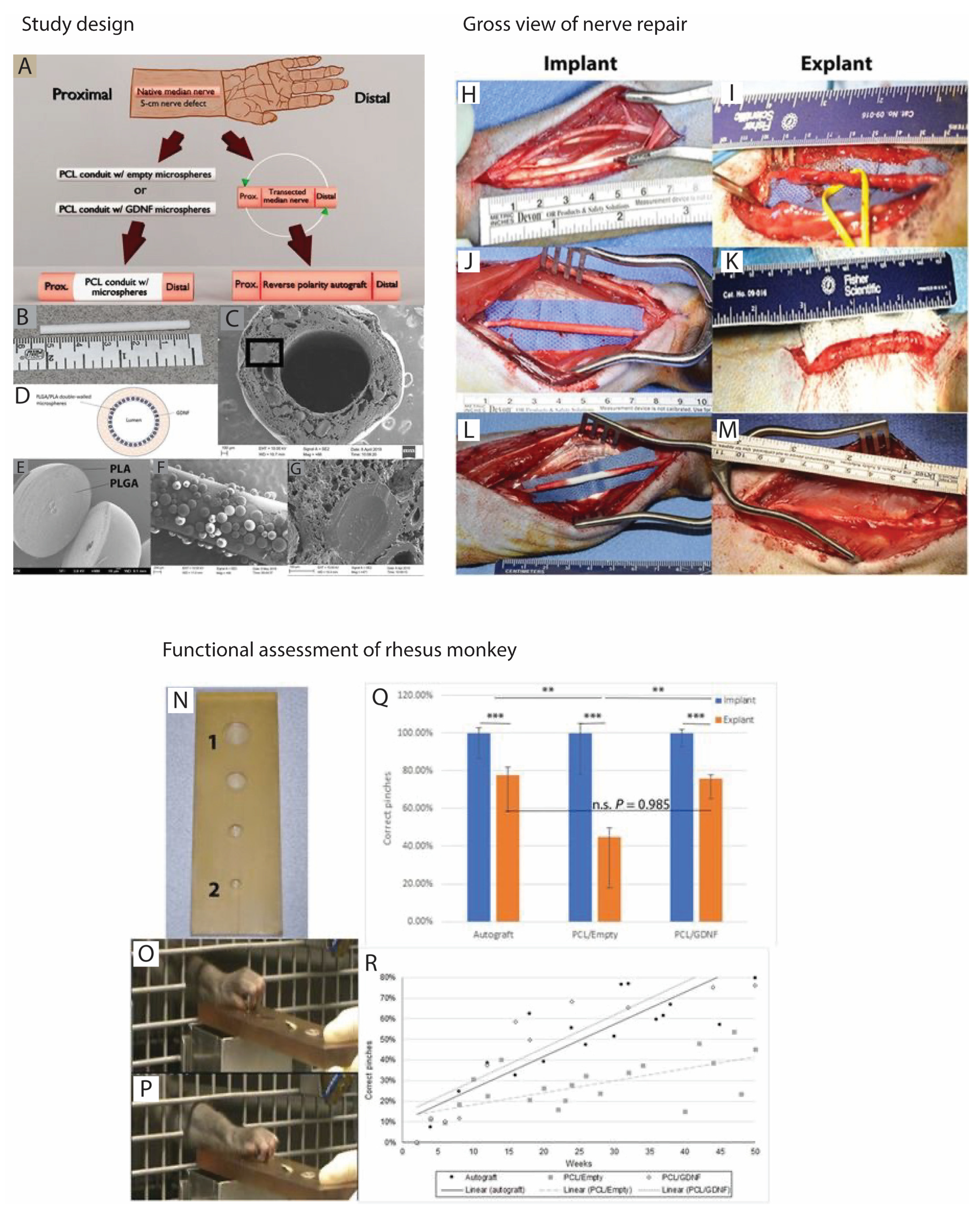
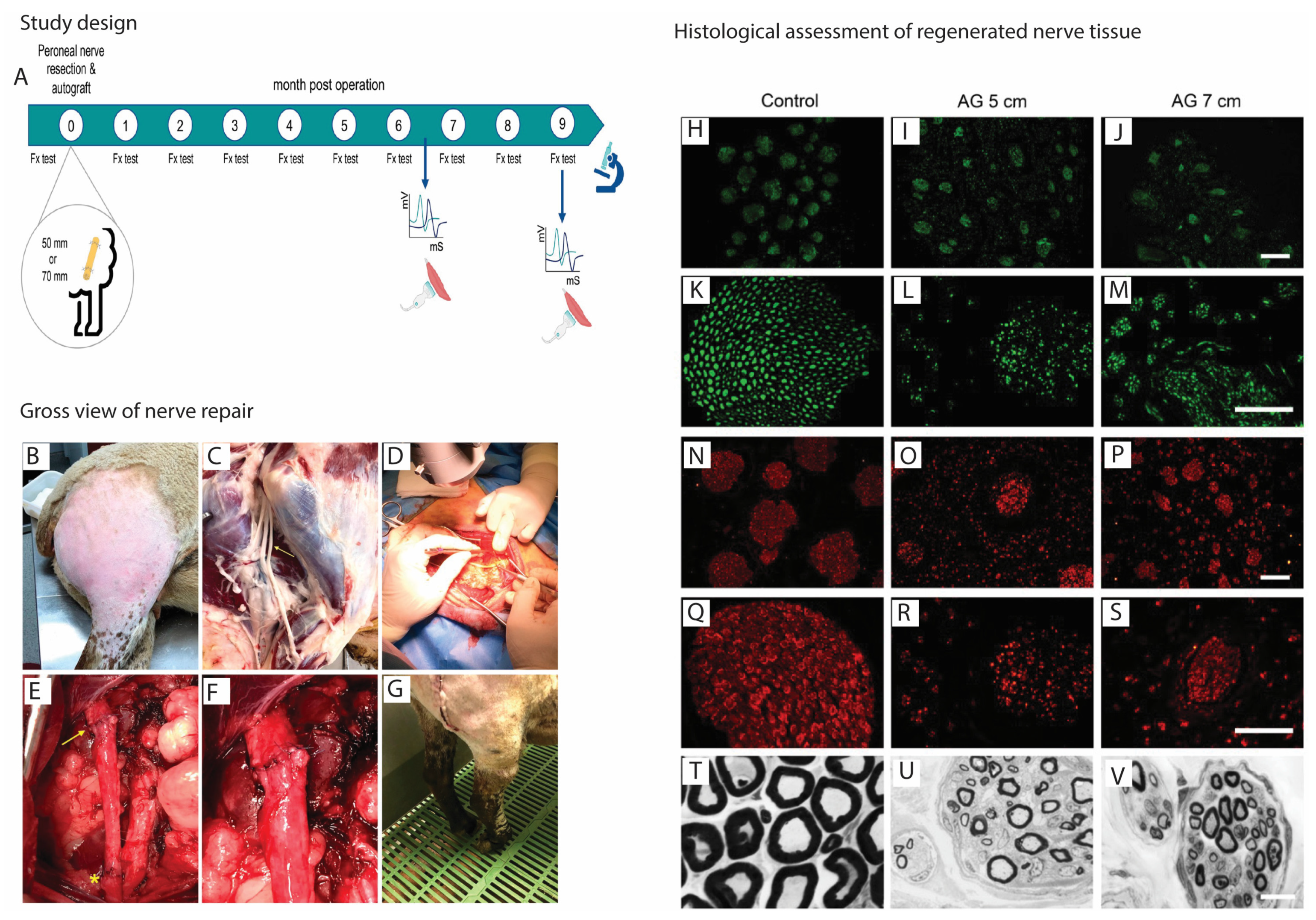
Disclaimer/Publisher’s Note: The statements, opinions and data contained in all publications are solely those of the individual author(s) and contributor(s) and not of MDPI and/or the editor(s). MDPI and/or the editor(s) disclaim responsibility for any injury to people or property resulting from any ideas, methods, instructions or products referred to in the content. |
© 2023 by the authors. Licensee MDPI, Basel, Switzerland. This article is an open access article distributed under the terms and conditions of the Creative Commons Attribution (CC BY) license (https://creativecommons.org/licenses/by/4.0/).
Share and Cite
Lischer, M.; di Summa, P.G.; Petrou, I.G.; Schaefer, D.J.; Guzman, R.; Kalbermatten, D.F.; Madduri, S. Mesenchymal Stem Cells in Nerve Tissue Engineering: Bridging Nerve Gap Injuries in Large Animals. Int. J. Mol. Sci. 2023, 24, 7800. https://doi.org/10.3390/ijms24097800
Lischer M, di Summa PG, Petrou IG, Schaefer DJ, Guzman R, Kalbermatten DF, Madduri S. Mesenchymal Stem Cells in Nerve Tissue Engineering: Bridging Nerve Gap Injuries in Large Animals. International Journal of Molecular Sciences. 2023; 24(9):7800. https://doi.org/10.3390/ijms24097800
Chicago/Turabian StyleLischer, Mirko, Pietro G. di Summa, Ilias G. Petrou, Dirk J. Schaefer, Raphael Guzman, Daniel F. Kalbermatten, and Srinivas Madduri. 2023. "Mesenchymal Stem Cells in Nerve Tissue Engineering: Bridging Nerve Gap Injuries in Large Animals" International Journal of Molecular Sciences 24, no. 9: 7800. https://doi.org/10.3390/ijms24097800
APA StyleLischer, M., di Summa, P. G., Petrou, I. G., Schaefer, D. J., Guzman, R., Kalbermatten, D. F., & Madduri, S. (2023). Mesenchymal Stem Cells in Nerve Tissue Engineering: Bridging Nerve Gap Injuries in Large Animals. International Journal of Molecular Sciences, 24(9), 7800. https://doi.org/10.3390/ijms24097800








